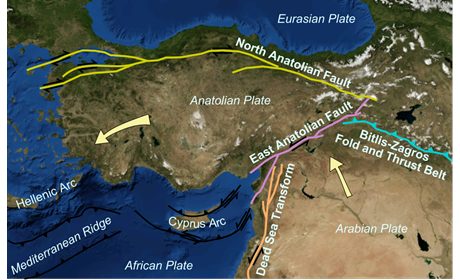Around 4 am local time on Monday, February 6, two tectonic plates slipped past each other just 12 miles below southern Turkey and northern Syria, causing a 7.8 magnitude earthquake. It was the largest earthquake to hit Turkey in over 80 years. Then, just nine hours later, a second quake-registered at 7.5 magnitude-struck the same region.
The double whammy of intense shaking collapsed thousands of buildings and killed over 20,000 people, leaving behind a humanitarian crisis in an already vulnerable area. The epicenter of the quakes was near the city of Gaziantep, where there are currently hundreds of thousands of Syrian refugees. Aleppo, a city in Syria that has been destroyed by civil war, also felt the brunt of the earthquakes.
Seismologists consider Turkey a tectonically active area, where three tectonic plates-the Anatolia, Arabia, and Africa plates-touch and interact with each other. The two major fault lines surrounding it, the North Anatolian Fault and the East Anatolian Fault-which has a slip rate of between 6 and 10 millimeters per year-are gradually squeezing the country westward toward the Mediterranean Sea. Yet, many buildings in the region are not built to withstand large earthquakes, according to the US Geological Survey (USGS), making the destruction worse.

"Even if we had told all of those people the day before, or the week before, and everyone got out safely, but all those buildings still collapsed, this would still be a humanitarian tragedy," says Rachel Abercrombie, a Boston University College of Arts & Sciences research professor of Earth and environment. She has been studying earthquakes for over three decades, aiming to understand what makes some more severe than others, how they start, and what actually happens at the earthquake source. The president of the American Geophysical Union's seismology division, she is also a coleader at the Southern California Earthquake Center, which works to improve measurements of stress caused by earthquakes.
Why were the two earthquakes so catastrophic? To put their cascading devastation into context, The Brink spoke with Abercrombie about why the region is at high risk for earthquakes and what can be done to warn people about an impending shake before it's too late.
This interview was edited for length and clarity.
Hours after the two earthquakes, the BU Turkish Student Association began raising money to aid the ongoing recovery efforts, aiming to reach $20,000 for search and rescue efforts. Members of the BU community who have been affected by the earthquakes can find counseling and support through Behavioral Medicine, the University Chaplains Office, and the Faculty & Staff Assistance Office.






